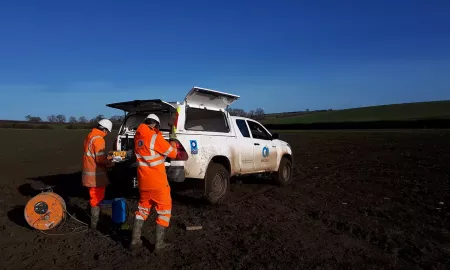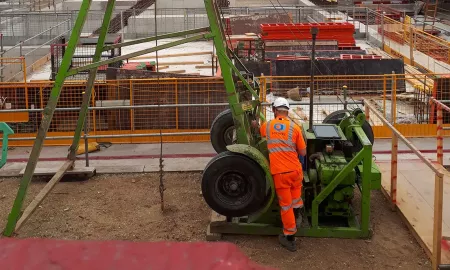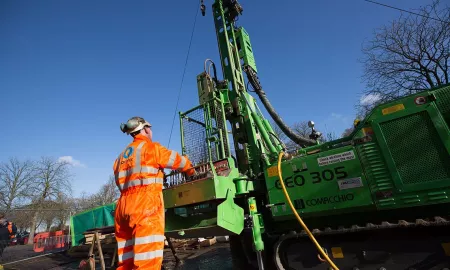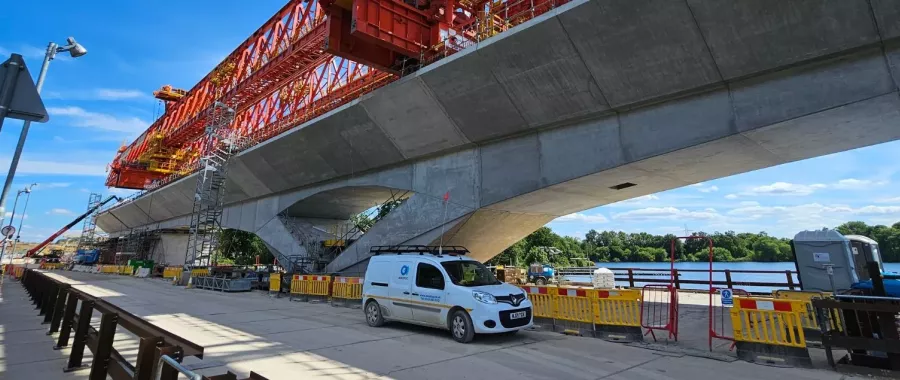Harry Higgs has worked in SOCOTEC’s Ground Investigation division for the last three years and currently holds the position of senior geophysicist. In this blog, Harry explains the bespoke nature of his role and the importance of clear communication and accuracy within the geophysical sector.

What does a typical day as a geophysicist look like?
With so many different clients and site locations, a geophysicist’s day on site varies greatly depending upon the geophysical nature of the work. For instance, it may involve operating a radar on the side of a building in central London, or hammering the ground as part of a seismic survey in a remote field somewhere in Aberdeenshire. As I split my time across a mixture of site and office-based work, it is common practice for a geophysicist to engage in every aspect of the project from start to finish.
What sorts of projects have you worked on? Are there any that are of particular interest/high profile?
Most of the projects I have been involved in are during the pre-construction phase, which allows us to work closely with SOCOTEC’s wider ground investigation team. We have undertaken borehole geophysics for geotechnical parameters, mapped bedrock across rivers and even searched for suspected burial pits. Recently, our team has been working to build links with universities to help us secure the best graduate talent and with SOCOTEC directly funding industrial research into track bed tomography methods, this will keep us at the forefront of innovation within the geotechnical sector. Finally, we have been working alongside SOCOTEC Monitoring on the Proactive Infrastructure Monitoring and Evaluation (PRIME) Project which represents another significant step forwards in the capabilities of applied geophysical monitoring.
What would you say is the most unique aspect of your job?
The most unique aspect of my role is within the projects themselves, as each is bespoke and requires an approach that is specific to the site. This applies at every stage of the work cycle, so whether I am undertaking an office or site-based role, each job has its own unique challenges. Another interesting point is the pace of development within near surface geophysics. The equipment and software becomes more capable every year, and the range of engineering problems that are suitable for geophysics increases. This ensures that nothing stays stationary for long in this sector.
How did you become a geophysicist? Do you require specific training/qualifications?
My degree in Geophysics and Seismology from the University of Leeds meant that I gained a strong theoretical background in geophysical sciences. Once I had finished university, I was able to secure a graduate geophysicist role which I stayed in for three years, before securing employment with SOCOTEC as a surveyor in 2016. From there, I was able to work my way through the ranks, becoming a geophysicist in 2017 and securing my current role as a senior geophysicist in early 2019. All of the practical skills I have obtained have come directly from on the job experience, and I now have a strong background in processing and interpreting data and implementing a range of multidisciplinary geophysical techniques.
How does your role as a geophysicist fit in with the broader project delivery?
Geophysical surveys are often specified as a percentage of any medium to large site investigation budget, which means that we often work alongside geologists to provide data that adds to a ground model. This may be at the very initial stages of a project to map large areas to inform borehole positions; for example, during utility surveys, magnetic surveys for unexploded ordnance or electromagnetic mapping for voids, leachates or buried foundations. Geophysics may also be applied during a project, which can involve using ground penetrating radar or seismics to provide structural information, or when the unexpected is discovered on site and needs to be mapped before remediation can be undertaken.
What sort of challenges do you face in your role?
The greatest challenge that I experience within each project is having to ensure clear communication at all levels. This requires me to manage client expectations throughout, from the geophysical survey itself to the final report stages. While this can be a difficult line to walk, it is nonetheless an important one to get right.
What do you enjoy the most about your role/working for SOCOTEC?
What I enjoy the most about my role is applying geophysical techniques and knowledge to solve specific ground engineering problems. No two projects are the same, so there is always the opportunity to apply my knowledge in different ways. The best thing about being a SOCOTEC employee is working alongside a great group of colleagues, as well as having a supportive management who encourage us to use our initiative and push ourselves, whether through skills development or the generation of lasting client relationships.
Do you have any advice for anyone looking to start a career as a geophysicist?
Geophysics can offer an interesting and varied profession, with the option to work anywhere in the world. It is a growing market, so if you enjoy problem solving and applied science then it could be a great career choice. I’d advise anyone starting out to ask lots of questions early on, as it is the best way to learn the practical skills that university doesn’t teach you.
Want to find out more about SOCOTEC's site investigation services?

You might also like







Add new comment